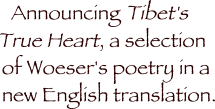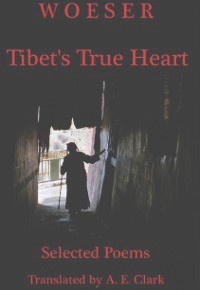Teaching Patriotism in Tibet
‘Teaching patriotism’ has been an enormous, long−term project. To trace its history in the Tibetan region, one must start with my parents’ generation. I have a book about the Seventeen−Point Agreement that was published in Beijing in 1951. It’s a parallel−text edition in Tibetan and Chinese, and it’s bound in red leather. The first sentence is “The Tibetan nationality is one of the nationalities within the borders of China that have a long history.” So began the first rivulet of ‘patriotism education’ in the Tibetan region. From this came the huge waves that have washed over the minds and spirits of at least three generations of Tibetans.
‘Patriotism education’ has developed over time, and it has been aimed at specific enemies. In 1950, when the army first massed on the border, the rationale for ‘liberating’ Tibet was that ‘imperialist forces’ were oppressing it. The red leather−bound book also says that prior to this, “The local government of Tibet had failed to combat the deceitful, divisive mischief of Imperialism and had adopted an unpatriotic attitude toward the great motherland.” After the Tibetans’ revolt was put down and the Dalai Lama went into exile in 1959, patriotism education then settled on new enemies: “Old Tibet” and its representatives, the “elite clique of reactionaries” headed by the Dalai Lama. Under the influence of Communist China’s powerful distortions and propaganda, the traditional social system of Tibet came to be defined as the “most reactionary, most obscurantist, most anachronistic, most cruel and barbarous feudal serf society,” and Tibetans were defined as having belonged to one of two classes: the serf−owners or the serfs. The former had to be overthrown, while the latter, it was said, had risen to the top. Anyone born, like me, in the Sixties of the last century is very, very familiar with this textbook.
When the mid−nineties came, after the authority to select the young reincarnation of the Tenth Panchen Lama was ripped from the Dalai Lama’s hands, Communist China’s proconsul in Tibet, Chen Kuiyuan, decided “to roll out patriotism education in temples across the whole region.” The goals of this move were
That last point involved a decree from the top that set up an office for a “Love your country, love your religion” campaign. After a few years of trial in pilot programs, this would be triumphantly expanded. Actually, the work teams which the Party dispatched and stationed in each temple (large or small) did only two things to the 46,000 monks and nuns who were officially registered: one was to require them all to acknowledge that “Tibet is an inseparable part of China”; the other was to require them all to denounce the Dalai Lama as
This became the template for Tibetan areas of Gansu, Qinghai, Sichuan, and Yunnan Provinces. It led to a purge — carried out with varying degrees of intensity — of more than 150,000 monks and nuns. But in every case, at whatever temple, ‘patriotism education’ encountered resistance from the monks and nuns. Although the work teams sometimes reduced what they required to a simplified declaration, “I ardently love China, and I don’t believe in him,” there were still many religious who proved unwilling to use this ‘him’ to refer to their spiritual leader the Dalai Lama, and were even more unwilling to deny their faith.
For many years now, tragedies have befallen every Tibetan district, every sect. In Lhasa, there was the mysterious death of a monk at Drepung Monastery. In northern Kham at Serthar, the residences of the Buddhist doctrinal institute were largely demolished; the Karmapa, head of the Kagyu sect, as well as Arjia Rinpoche, the presiding abbot of Kumbum in Amdo, were forced to flee one after the other. In southern Kham, Tenzin Delek Rinpoche as well as countless monks and nuns were unjustly imprisoned. The fruits of ‘patriotism education’ would more than fill a book.
After what happened in March, teaching patriotism moved to the very top of the agenda across the whole Tibetan region. And this time, in addition to holding daily political classes and political examinations for monks and nuns, every monastery has received a new requirement: they must fly the Chinese flag. Under the stress of this kind of incremental compulsion, it’s hard to foretell what tragedies, and what acts of resistance, are still to come.
Woeser wrote this article for Radio Free Asia’s Tibetan−language service. It was posted to her blog on September 17, 2008.
Translator’s Notes
Teaching Patriotism. The Chinese term is usually translated “patriotic education,” which in English implies an education of general scope that has been imbued with or colored by patriotic values. The Chinese expression denotes a program whose sole aim is to instill patriotism. I have used the clunky term “patriotism education” in the belief that it better reflects the meaning of the original.
The Tibetan region. In Chinese, zangdi, including all the areas of traditional Tibet, not only those within the T.A.R.
The Seventeen−Point Agreement. The formal name for this 1951 treaty was Agreement of the Central People’s Government and the Local Government of Tibet on Measures for the Peaceful Liberation of Tibet. Most Chinese consider it to have been a valid agreement settling the legal status of Tibet. Most Tibetans judge it to have been signed under duress by a Tibetan representative who exceeded his authority. The Agreement is remarkable for its stipulation of local autonomy and freedom of religion.
authority to select the young reincarnation of the Tenth Panchen Lama. See Tibet’s True Heart, pp. 90−92.
the 46,000 monks and nuns. The quota for licensed or registered religious (in the T.A.R. alone) that was imposed during the 1990s after the Third Forum on Work in Tibet.
the mysterious death of a monk at Drepung Monastery. Ngawang Jangchub, 28, died in October 2005 after a session of patriotic education at the monastery. See Tibetan Centre for Human Rights and Democracy, Human Rights Update November 2005, “Arrests of Monks and Sit−in Protest in Drepung Monastery in Lhasa”, available at www.tchrd.org.
the residences of the Buddhist doctrinal institute. Woeser is referring to the monastic encampment of Larung Gar at Serthar, where thousands of students of Buddhism had taken up residence to study their faith and the monastic life. The expulsions and demolition occurred in the late spring of 2001. A bulletin with photographs is at the International Campaign for Tibet.
Tenzin Delek Rinpoche For a thorough summary of the life, work, and persecution of Tenzin Delek, see the report by Human Rights Watch. Woeser mentions her encounter with this man and writes about him in "Tibet’s Secret" (Tibet’s True Heart, pp. 45−46)


